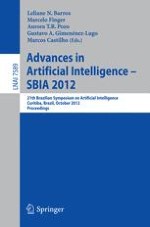2012 | Buch
Advances in Artificial Intelligence - SBIA 2012
21th Brazilian Symposium on Artificial Intelligence, Curitiba, Brazil, October 20-25, 2012. Proceedings
herausgegeben von: Leliane N. Barros, Marcelo Finger, Aurora T. Pozo, Gustavo A. Gimenénez-Lugo, Marcos Castilho
Verlag: Springer Berlin Heidelberg
Buchreihe : Lecture Notes in Computer Science
